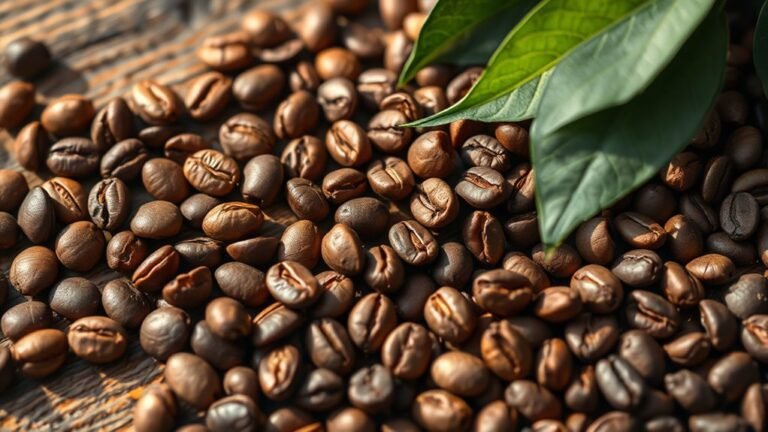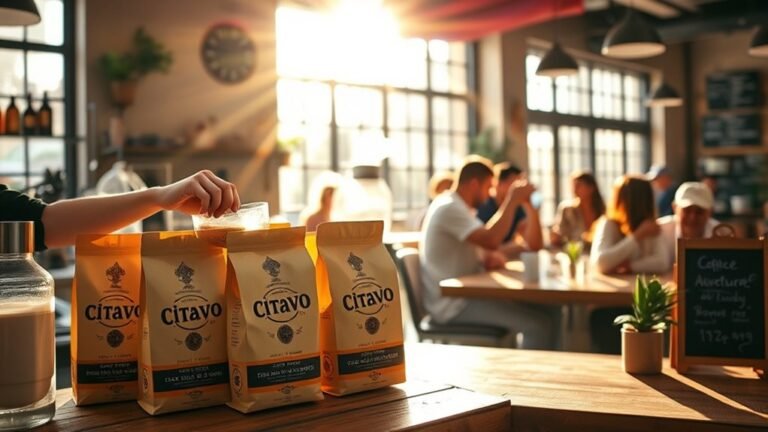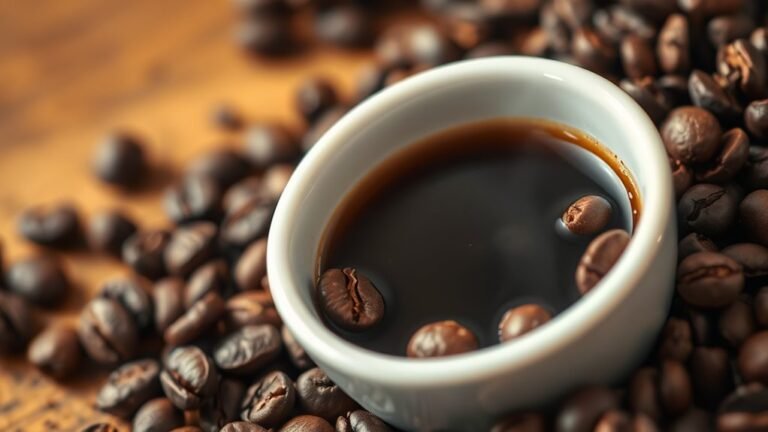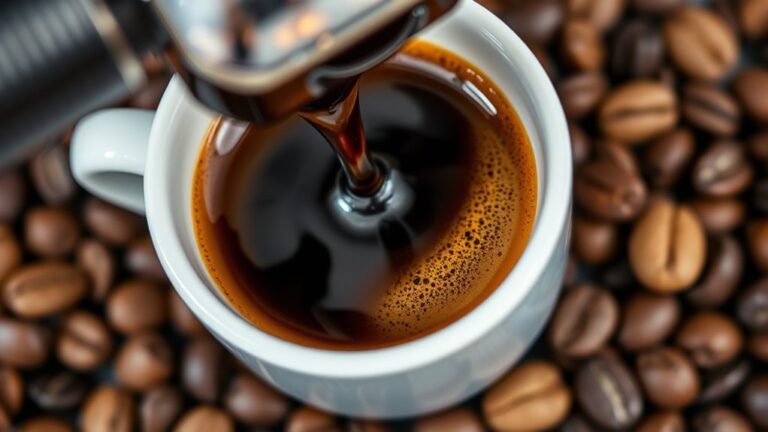The Best Decaf Coffee for Vietnamese Coffee
You want a decaf coffee that captures the bold, rich flavor of Vietnamese brew, with its chocolatey, slightly bitter notes and smooth finish. Opt for decaf made via the Swiss Water or CO2 method to preserve those vibrant undertones while reducing acidity and harshness. Brands like Trung Nguyên and Highlands Coffee offer authentic decaf blends perfect for your phin filter brew. Keep your grind fresh and fine for balanced extraction, and add sweetened condensed milk for that classic touch. There’s plenty more to explore on mastering your perfect cup.
Understanding the Flavor Profile of Vietnamese Coffee

Although you might be familiar with the bold and robust taste of traditional Vietnamese coffee, understanding its unique flavor profile is key to appreciating what makes it so special. Vietnamese coffee offers rich taste nuances, ranging from the strong, slightly bitter notes to subtle hints of chocolate and caramel. These layers come alive thanks to the regional varieties of coffee beans grown across Vietnam’s diverse climates. Whether it’s the Central Highlands’ earthy tones or the sweeter, fruitier notes from the northern regions, each variety adds its own character to the brew. When you savor Vietnamese coffee, you’re not just drinking coffee; you’re experiencing a tapestry of flavors shaped by geography and tradition—perfect for those who crave freedom in every sip.
How Decaf Coffee Is Made
When you choose decaf coffee, it’s helpful to know how caffeine is removed from the beans. Common methods like the Swiss Water Process or CO2 extraction gently pull out caffeine while preserving flavor. Understanding these techniques can help you pick a decaf that still delivers the rich taste you love in Vietnamese coffee.
Common Decaffeination Methods
Since you’re curious about how decaf coffee is made, it helps to know that there are several common methods used to remove caffeine from coffee beans, each affecting flavor and quality in different ways. One popular approach is solvent extraction, where natural or synthetic solvents selectively strip caffeine while preserving other compounds. Then, there’s the Swiss water method, which uses pure water and osmosis to gently wash caffeine away without chemicals, ideal if you want a chemical-free process. Both methods aim to maintain the bean’s core character, letting you enjoy your Vietnamese coffee with less caffeine but plenty of soul. Understanding these techniques gives you the freedom to choose decaf options that suit your taste and lifestyle perfectly.
Impact on Coffee Flavor
Because the decaffeination process involves removing caffeine, it inevitably influences the flavor profile of your coffee. When caffeine is extracted, some of the compounds responsible for the rich decaf flavor and enticing coffee aroma can also be affected. This means your Vietnamese coffee might taste a bit different than its caffeinated counterpart. However, with advances in decaffeination techniques, the impact is less severe than before. Here’s what you might notice:
- Slightly muted coffee aroma, making it less intense
- Softer, sometimes milder decaf flavor with fewer bitter notes
- Potential loss of some bright or fruity undertones
- A smoother, less acidic finish, which can appeal to many
Understanding this helps you appreciate how decaf coffee still offers freedom without sacrificing enjoyment.
Criteria for Choosing the Best Decaf Coffee for Vietnamese Brewing
When choosing decaf coffee for Vietnamese brewing, you’ll want to focus on how the flavor profile complements the traditional sweet and creamy notes. Consider your roast level preference, as it greatly affects the boldness and richness of your cup. Also, keep in mind that the decaffeination method can influence the taste, so selecting one that preserves flavor is key.
Flavor Profile Compatibility
Although decaf coffee often gets overlooked for its flavor nuances, choosing the right profile is essential if you want to capture the bold, rich essence of traditional Vietnamese coffee. You’ll find that not all decaf varieties fit this profile equally. To truly enjoy that signature Vietnamese brew, look for flavor profiles that complement the intense sweetness and creamy texture of condensed milk.
Consider these key flavor elements:
- Nutty undertones to add warmth without overpowering
- Chocolate hints for that classic richness
- Subtle fruitiness to brighten the cup gently
- Low acidity to maintain smoothness and balance
Roast Level Preferences
Selecting the right roast level is essential if you want your decaf coffee to shine in a traditional Vietnamese brew. You’ll find that a dark roast suits this style perfectly, delivering bold, rich flavors with a smoky finish that complements the sweetened condensed milk typically used. However, if you prefer a brighter, more nuanced cup, a light roast can offer delicate floral and fruity notes, adding complexity without overpowering the brew’s character. Choosing between light roast and dark roast comes down to your taste freedom—whether you crave intensity or subtlety. Remember, the roast level influences not just flavor but also body and acidity, so pick one that aligns with how you want your Vietnamese coffee to feel and taste every time.
Decaffeination Method Impact
Because the decaffeination method shapes both flavor and aroma, it plays an essential role in choosing the best decaf coffee for Vietnamese brewing. When you select your decaf coffee, understanding how the process impacts the flavor nuances and preserves the decaf origins is key to revealing that rich, bold profile you crave. Different methods affect the coffee’s character, so consider these:
- Swiss Water Process: Chemical-free, retaining natural flavors and smoothness.
- CO2 Method: Preserves bold flavor nuances, great for robust decaf origins.
- Chemical Solvent Method: Efficient but may mute subtle aromas.
- Water Process: Gentle, but can alter acidity and brightness.
Knowing these helps you pick a decaf that keeps your Vietnamese coffee vibrant and satisfying, letting you enjoy freedom in every cup.
Top Decaf Coffee Brands for Authentic Vietnamese Flavor
When you’re aiming to capture the rich, bold essence of traditional Vietnamese coffee without the caffeine buzz, choosing the right decaf brand is essential. Look for decaf brands that prioritize quality beans and use gentle decaffeination methods to preserve that authentic flavor you crave. Brands like Trung Nguyên and Highlands Coffee offer decaf options that stay true to the robust, earthy notes distinctive to Vietnamese coffee. Additionally, some specialty roasters craft decaf blends specifically designed to mimic the full-bodied intensity and slight bitterness typical of Vietnamese brews. By selecting these top decaf coffee brands, you can indulge in the classic, rich taste without sacrificing your freedom from caffeine. Your perfect cup of Vietnamese decaf coffee is closer than you think.
Brewing Tips for Decaf Vietnamese Coffee

Brewing decaf Vietnamese coffee requires a careful balance to bring out its signature boldness and smooth texture. To master the process, you’ll want to focus on precise brewing techniques and the right coffee accessories. Start with a quality phin filter, which lets you control the drip rate, and use freshly ground decaf beans for maximum flavor. Keep water just off the boil to avoid bitterness, and allow the coffee to slowly drip for a rich, concentrated brew.
Master decaf Vietnamese coffee with precise brewing, a quality phin filter, and fresh beans for bold, smooth flavor.
Here are some tips to get you started:
- Use coarse ground coffee for ideal extraction.
- Pre-wet the grounds to bloom and release aromas.
- Control the drip speed by adjusting the phin’s press.
- Serve over sweetened condensed milk for the classic taste.
Enjoy your freedom to brew the perfect decaf Vietnamese coffee!
Enhancing Your Decaf Vietnamese Coffee Experience
How can you elevate your decaf Vietnamese coffee beyond just a simple cup? Start by exploring decaf alternatives like chicory or roasted barley, which add complexity while keeping caffeine at bay. Don’t hesitate to experiment with flavor enhancements—try a dash of cinnamon or a splash of vanilla extract to awaken your senses. Using rich, creamy condensed milk remains a classic, but you can also swap it for coconut milk for a tropical twist that complements the coffee’s bold profile. Adjust the grind size and brewing time to bring out subtle notes you might miss otherwise. By embracing these simple tweaks, you’re not just making coffee—you’re crafting a liberating ritual that lets you enjoy bold flavors without compromise. Your perfect decaf Vietnamese coffee journey starts with these creative choices.
Frequently Asked Questions
Can I Use Instant Decaf Coffee for Vietnamese Drip Brewing?
Imagine the rich aroma filling your kitchen as you prepare to brew Vietnamese coffee. Now, can you use instant coffee in that classic drip setup? Instant coffee isn’t designed for brewing techniques like the traditional Vietnamese drip filter; it dissolves instantly, skipping the slow extraction process that builds flavor. While instant decaf can be quick, it won’t capture the bold, layered taste you crave. For freedom in flavor, stick to ground coffee.
How Does Water Temperature Affect Decaf Vietnamese Coffee Taste?
When you brew decaf Vietnamese coffee, water temperature plays a big role in revealing the right flavor profiles. Too hot, and you risk bitterness; too cool, and the brew might taste weak or under-extracted. Experiment with brewing techniques, aiming for water around 195-205°F to balance boldness and smoothness. By tweaking temperature, you gain freedom to craft a cup that highlights the unique, rich character decaf coffee can offer without sacrificing depth.
Is It Safe to Consume Decaf Coffee Daily?
Did you know that about 54% of Americans drink coffee daily? If you’re considering decaf, you’ll be glad to know daily consumption is generally safe and comes with health benefits like reduced anxiety and less caffeine-related jitters. Decaf still contains antioxidants, so you can enjoy your cup freely without the buzz. Just remember, moderation is key—too much of anything can tip the balance. So go ahead, savor that soothing sip every day!
What Equipment Is Best for Making Vietnamese Iced Coffee?
If you want to make authentic Vietnamese iced coffee, you’ll need a Vietnamese drip, a small metal coffee filter that sits atop your cup. It’s perfect for slow-brewing strong, flavorful coffee right at home. Pair it with coffee filters designed specifically for this drip to keep grounds out but let the rich brew through. This setup lets you control strength and enjoy that bold, sweet iced coffee freedom whenever you like.
How Long Can I Store Brewed Decaf Vietnamese Coffee?
When it comes to brewed storage, you want to keep your decaf Vietnamese coffee fresh as long as possible. Ideally, you should consume it within 12 hours if kept at room temperature, but refrigerating it can extend coffee freshness up to 24 to 48 hours. Just store it in an airtight container to preserve that rich, bold flavor you love. Don’t wait too long, or your coffee’s vibrant taste will start to fade.






